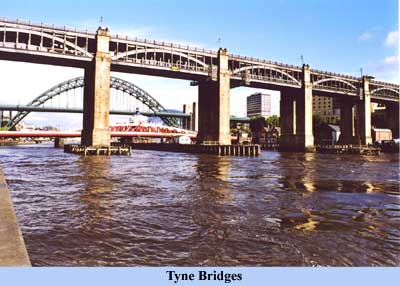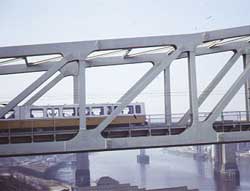
TYNESIDE BRIDGES

"Then at last...the wide opening of the new Tyne bridge, Newcastle. Beyond and below the bridge's severe beauty of curved stel lie the quaysides which the keelmen knew and the narrow, cobbled chares leading down to them. Down river the oily wash of waters between quayside warehouses, docks and slipways, with groups of slim cranes like fishing herons. Tugs, barges, tramps and steamers with flags of all nations. Upstream a vista of bridges."
About Britain - The Lakes To Tyneside. Sid Chaplin. 1951.
"Everywhere from the dancing waters of the harbour to the ebb and flow of the throbbing city (are) industry, resource and expansion, coal staiths, shipyards, engine shops, dry docks, chemical works, forges, electrical lighting laboratories, warehouses, merchant's offices, steamships, railway trains, without end, without number - from Shields to Scotswood there is not its like in any thirteen mile of river the world over."
The Making Of the Tyne. R W Johnson. 1895.
The bridges over the Tyne between Newcastle and Gateshead are justifiably famous. They are not merely bridges, but icons for the North East. Over the years the single (Georgian) bridge existing in the early Victorian period has been joined by six others. First the High Level Bridge, giving the river its first railway crossing, then the Swing Bridge (replacing the Georgian bridge), and the first Redheugh Bridge, replaced twice, to be followed by the King Edward Bridge and the most famous of them all, the new Tyne Bridge. After many decades came the Queen Elizabeth Metro Bridge and finally, in 2001, the Gateshead Millennium Bridge opened to provide a stunning pedestrian and cycle link between the redeveloped quaysides on either side of the river. In the space of less than a mile seven bridges link Newcastle with Gateshead.
Further upstream are bridges at Scotswood and Newburn, the old Chain Bridge at Scotswood being one of the oldest until replaced in 1967. A major tributary, the Derwent, flows into the Tyne on its south bank near Swalwell. Former Tyneside bridges and the various tunnels, ferries and proposals for other crossings are dealt with in other parts of the site. In any account of the bridges, ferries and tunnels on Tyneside the role of the Tyne Improvement Commission (TIC) must be considered. They always sought to safeguard the interests of shipping and riverside economic interests and ensure no river crossings interfered with navigbation on the Tyne.
The 'Coaly Tyne', as it was called because of its domination by the coal trade, has also seen shipyards like Swan Hunters, Hawthorn Leslies and Readheads, great engineering works like Reyrolles, Parsons, Clarke Chapmans and Armstrongs as well as a host of smaller enterprises along its banks making all manner of things. Staiths also lined the banks up to 15 miles upstream, pouring a non-stop flow of coal into the holds of ships bound for many countries. Here too, the river saw ships of all nations with their crews talking in unfamiliar tongues, mingling with the Geordie dialect and adding to the sights and sounds of Tyneside.
- Gateshead Millennium Bridge - 2001
- Tyne Bridge - 1928
- Swing Bridge - 1876
- High Level Bridge - 1849/50
- Metro Bridge - 1981
- King Edward Bridge - 1906
- Redheugh Bridge - 1983
- Scotswood Bridge - 1967
- Scotswood Railway Bridge -1871
- Blaydon Bridge - 1990
- Lemington Bridge - 2001
- Newburn Bridge - 1893

